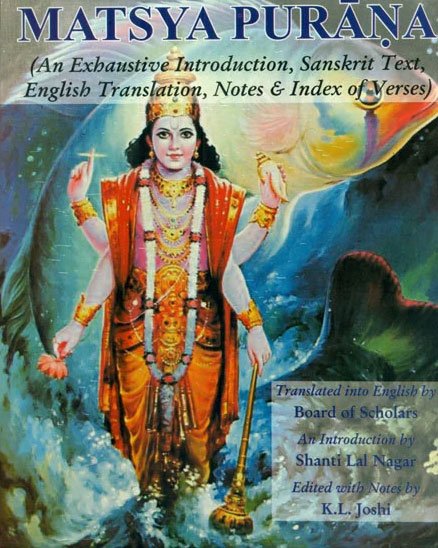The Matsya Purana (critical study)
by Kushal Kalita | 2018 | 74,766 words | ISBN-13: 9788171103058
This page relates ‘Geographical Aspects of the Puranas (Introduction)’ of the English study on the Matsya-purana: a Sanskrit text preserving ancient Indian traditions and legends written in over 14,000 metrical verses. In this study, the background and content of the Matsyapurana is outlined against the cultural history of ancient India in terms of religion, politics, geography and architectural aspects. It shows how the encyclopedic character causes the text to deal with almost all the aspects of human civilization.
Geographical Aspects of the Purāṇas (Introduction)
The Purāṇas are regarded as the stockpile of ancient geography. So far as Indian geography is concerned the epics and Purāṇas can be recognised as the source of information about ancient India. They have given some exact accounts of the rivers, mountains, lakes, forests, deserts, countries and also about territorial divisions of India.[1] The Geography of India was basically dependent on the prevailing religious and political character of the period which it embraces. The geographical data in different Purāṇas have similarities. The account described in one is often repeated in another pointing to their single original source.
Most of the Purāṇas depicted the geographical pictures of the world in general and of Bhārata in particular. Purāṇas like Matsyapurāṇa, Vāyupurāṇa, Brahmapurāṇa, Viṣṇupurāṇa, Bhāgavatapurāṇa, Vāmanapurāṇa Brahmāṇḍapurāṇa, Śivapurāṇa, Agnipurāṇa, Mārkaṇḍeyapurāṇa, Kūrmapurāṇa, Garuḍapurāṇa, Liṅgapurāṇa have discussed about bhūvanakoṣa or world geography. Among these the Vāyupurāṇa, Matsyapurāṇa, Mārkandeyapurāṇa, Brahmāṇḍapurāṇa, Barāhapurāṇa and Bhāgavatapurāṇa have given a vast description on world geography. Viṣṇupurāṇa, Kūrmapurāṇa, Śivapurāṇa and Agnipurāṇa have discussions on geography in a concise form. In some particular Purāṇas some special area is focused. As for example, the Agnipurāṇa emphasizes details of the ‘Gayā’ region, in the Bhūmikhaṇḍa of Padmapurāṇa the places of pilgrimages are focused.[2] Although the geographical description in the Matsyapurāṇa is very much similar to Vāyupurāṇa and some scholar claims it as a copied version, it bears great value for the ancient geographical study.
There are difficulties in finding this geographical data out from Purāṇas as it is not in a logical order. They are scattered with some other materials. Basically it is scattered in the midst of religious aspects as geography of India is mainly based on religion.
S. M. Ali in his The Geography of the Puranas stated,
“every physical phenomenon, every major or spectacular landmark on the earth’s surface has a religious background for Indians; every mountain peak, every river, every crag, every useful tree is sacred and is preserved in these traditions.”[3]
So a careful study is needed to assemble the Purāṇic geographical data in a systematic way.
The source of Purāṇic geography is the Vedic literature. The Ṛgveda mentions about few mountains and deals particularly with the natural phenomena which appealed to the aesthetic sense of the seers. The topography of the Ṛgveda is limited to the description of twenty one (21) rivers in all.[4] In it Sarasvatī, Sarayū and Sindhu are mentioned as the ‘leaders’ of these. Sarasvatī is of the first group,[5] Sindhu of the second group,[6] and the Sarayū of the third.[7] . Of the mountains, only the Himavanta[8] and Munjāvān[9] find a place in the Ṛgveda.
Like the Ṛgveda the Yajurveda, the Sāmaveda and the Atharvaveda, the Brāhmaṇas, the Āraṇyakas, the Upaniṣads and the Kalpasūtras also contain geographical material. The Southern mountain is mentioned in Kauśitakī Upaniṣad.[10] The name Vindhya occurs expressly in the Vaśiṣṭhadharmasūtra[11] and in the Manusmṛti.[12]
The Matsyapurāṇa gives a general view of the world geography. It mentions Jambudvīpa and describes Bhārata together with its Varṣas, Kulaparvatas, other innumerable mountains, rivers and cities. It refers to the various rivers grouping them according to the mountain ranges out of which they arise.
Footnotes and references:
[1]:
Bimal Churn Law, Historical Geography of Ancient India, Introduction, p.1
[2]:
S. M. Ali, The Geography of the Puranas, Introduction, p.13
[3]:
Ibid., p.15
[4]:
Ṛgveda, 5.53.9; 10.64.6; 75.5.6
[5]:
Ibid., 10.75.5
[6]:
Ibid.,10.75.6
[7]:
Ibid., 5.53.9
[8]:
Ibid., 10.121.4
[9]:
Ibid., 10.34.1
[10]:
Kauśitakī Upaniṣad, 11.13
[11]:
Vaśiṣṭhadharmasūtra, 1.9
[12]:
Manusmṛti, 11.21
